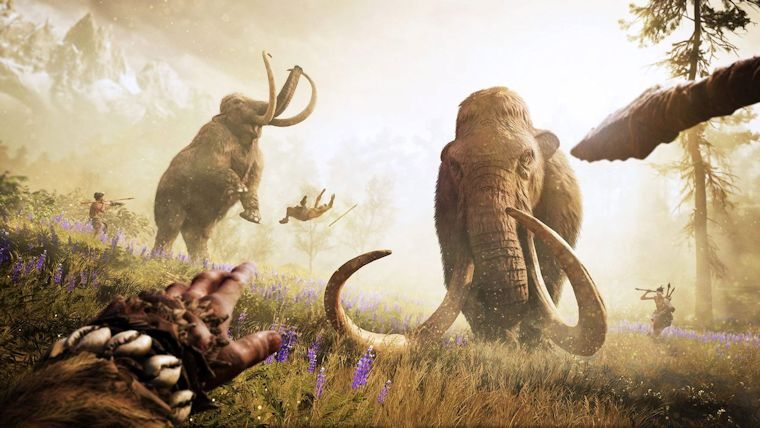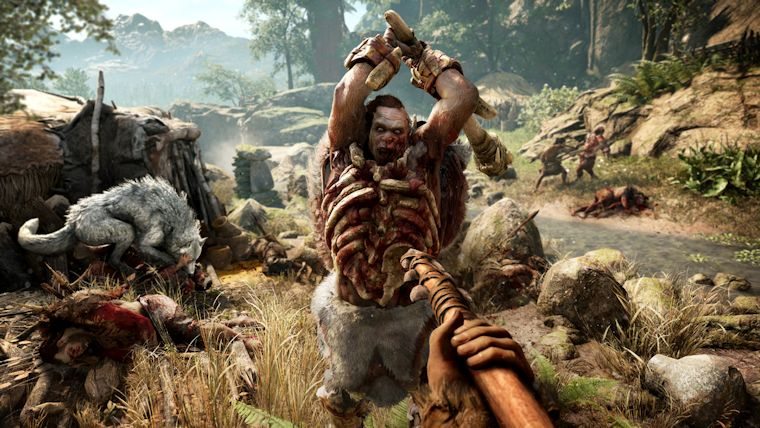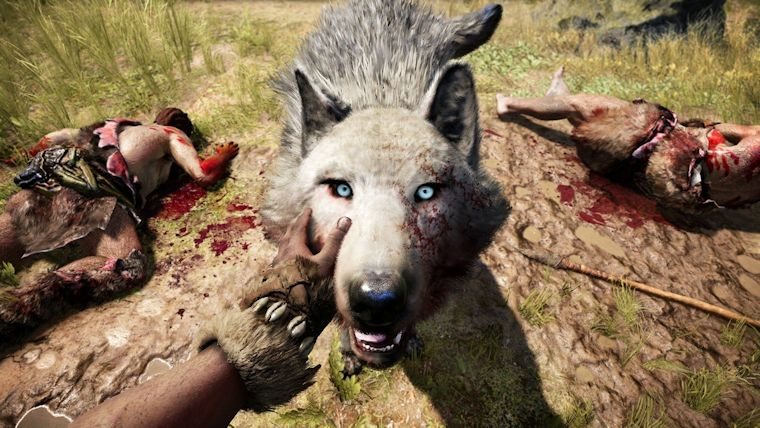The first person shooter genre has seen a large shift in focus to modern or futuristic style games over the last few years, mostly leaving the past behind. The Far Cry series has taken a similar approach by utilizing a close to present day time period throughout most of its series, except for Blood Dragon of course, but Ubisoft has decided to make a dramatic change with the setting in the prehistoric Far Cry Primal.
Far Cry Primal takes place in 10,000 BC at the start of the Mesolithic Era, which is a time period that gaming has rarely tackled. This dates the game millions of years after the end of the dinosaurs where human settlements are becoming more common, but animals like the mammoth still roamed the planet.
The story follows the protagonist Takkar, a member of the Wenja tribe, whose people are scattered after the destruction of their village at the hands of the rival Udam tribe. As a result, the ultimate goal in the game is to rebuild your village and take down your enemies. This premise is pretty simplistic, which extends to the game also. The story feels almost a little too straightforward throughout most of it, though there are a few character related twists involved. The story can be enjoyable in some parts but it still feels a bit lackluster throughout, especially when compared to the stellar story from Far Cry 3.
While the story may not be the most captivating, the entirely original language created for the game does a great job at enhancing it. Not only did the developers create a fictional language that is used throughout the entire game, but they took it a step further by creating dialects within this language for each of the main tribes. Some games are a little too ambitious with their created languages, coming off sounding too forced, but the one found in Far Cry Primal fits perfectly into the era.

Far Cry Primal instantly thrusts you into action while hunting a mammoth, before you become separated from everyone without your supplies or weapons. The fictional Oros is the setting for this open world adventure, where there is a vast landscape to explore. The art direction here is not too different from that of the last few games, with beautiful and lush areas almost everywhere. Though sometimes this vibrant landscape can feel a bit repetitive as the game drags on. Upon being separated from your pack, the game introduces one of its most important mechanics, gathering.
Throughout the vast open world, there are a large variety of different objects to interact with that will provide you with much needed supplies. These recovered items can then be used for a variety of tasks, including the creation of new weapons. While this is similar to what has been featured in past entries in the Far Cry series, it feels even more natural due to the hunter-gatherer society that was present in 10,000 BC.
The other half of the hunter-gatherer name is very important in Far Cry Primal, as there are a large variety of different animals to find throughout the land of Oros. Some of these animals are afraid of you and will run, such as goats and deer, but the more formidable ones like wolves, sabretooth tigers, and bears will search you out and try to kill you. This could have been a little problematic if the game featured slowdown in these fights, but the performance is top notch here. The wild animals play a major part in Far Cry Primal, as you will almost always get attacked while on the move, but luckily you have a variety of weapons to kill or ward them off.
Due to the game’s uncommon setting, the weapons you will have at your disposal are very different from the rest of the Far Cry series. The bow and arrow is still present, though in a much more primitive state, but guns are replaced with clubs, spears, and a sling. The most modern of the weapons found are a variety of different bombs and poisons, though they are still pretty basic. Many of the weapons can also be used in multiple ways, such as the spear being able to be thrown or used as a melee weapon. New weapons are unlocked the deeper you get into the game, which can then be made with the supplies found while exploring. This is made as simple as possible through the game’s menu, along with the ability to craft ammo through the easy to access weapons wheel.

There is an entirely other layer to the weapons in the game as well with the ability to light most anything on fire. After skinning animals, you will earn animal fat that can then be used to light weapons, like the club and arrows, on fire at any time. This has a lot of use, as it can be used to light the way in dark areas or even light enemies on fire. It doesn’t get much better than being attacked by a jaguar and accidentally lighting one on fire while trying to fend it off, leading to it charging away like a ball of fire. The shrubbery and ground can also catch fire, which can sometimes be a pain as you will start to damage yourself, but it is quite refreshing to not be limited in artificial ways.
The ability to light the way is very important throughout Far Cry Primal as a result of the game’s dynamic day/night system. The shift from day to night is almost similar to The Legend of Zelda, as more enemies come out to hunt at this time. This is made much harder with the game’s limited visibility that plagues some portions, though fire can make this easier to deal with. Larger quantities of predators is not the only change, as night actually offers exclusive animals and collectibles that can not be found otherwise, adding another dimension to the game. Fire is one of the key elements in the game, but it works very well in tandem with the game’s Hunter’s Vision.
Wild animals play a major part in Far Cry Primal
Hunter’s Vision is similar to what is found in many other games, including Tomb Raider’s Survival Instincts, where you can more easily see collectible materials, animals, and enemies in the wilderness. This can be done by pressing down the right analog stick for a few seconds, and it will stay active for a little while, which is very helpful to use with the rather confusing world map. The upside in Far Cry Primal is that the time period for this lasts much longer than some other similar games, including you being able to use it while moving, but it would have been much more effective if it would work on one simple button press, rather than having to press down a button for a few seconds every time.
As hunting and gathering is a big part of Far Cry Primal, that naturally transitions over into the game’s mission structure as well. The missions tend to be repeated quite a bit though, with the escort missions especially putting a damper on the game. Building up your newly formed village is central to the experience, with many different people to find and recruit. Upon finding specialists to join your village, you will gain new skills and weapons. Throughout the game, you can then upgrade their huts to unlock even more, with some being much more useful than others.
Tensay is one of the earliest specialists you will find in the main story and brings with him one of the best parts of the entire game, being a beast master. After going on a spirit quest brought on by Tensay, you will gain the ability to tame wild animals that you can then use as a companion for the rest of the game. This starts with the owl that can be used to scout areas and mark enemies, but after that you will gain access to many of the animals that you come across in Oros, including even leopards and bears. You are limited to smaller canines at the start, but through the game’s skill system, you can upgrade to gain access to much more.

The skill system goes way beyond just the beast master ability tree, as the other specialists you recruit will bring different skill types as well, including gathering skills, takedown skills, beast riding skills, boosts, and many more. These are upgraded through the game’s experience system that rewards you with skill points, with you able to choose just how you want to spend them. There are quite a few of these to unlock, which manages to add a lot of longevity to the game for the completionists.
The Verdict
Far Cry Primal may be the latest in the Ubisoft franchise, but it goes way back to the past for a very different setting. Even though the story itself feels pretty uninspired through most of the game, the original language helps to elevate it around this prehistoric setting. While the time period itself may be a far cry from the rest of the series, the game still manages to feel like a natural progression with some core gameplay elements intact, while also adding plenty of content, such as the beast master skills, that makes Far Cry Primal feel likes it own distinct experience.











Published: Feb 22, 2016 05:00 am